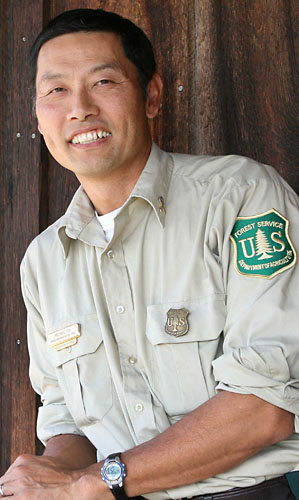home | internet service | web design | business directory | bulletin board | advertise | events calendar | contact | weather | cams

 Mike Liu, Methow Valley District Ranger, is facing $480,000 in road maintenance needs with only $80,000 to spend. (photo: Solveig Torvik) Mike Liu, Methow Valley District Ranger, is facing $480,000 in road maintenance needs with only $80,000 to spend. (photo: Solveig Torvik)Future of Forest Roads The U. S. Forest Service needs $480,000 to maintain the 561 miles of existing road in the Chewuch River drainage. But it has only $80,000 to spend, according to Methow Valley District Ranger Mike Liu. Something clearly has to give. So Liu and the Wilderness Society, with a shared $75,000 grant from Oregon-based Ecotrust, have teamed up to try to figure out what and where. "We've been limping along with these roads and they just get worse and worse", Liu says. By the end of September, he expects to release for public comment a recommendation that will reflect some initial public input gathered by the society, which, with the Forest Service, has co-hosted two public meetings and two field trips this summer. Their joint effort has been aimed at trying to get an early read on how the public wants to deal with these roads. A formal National Environmental Policy Act process will commence this fall, with a decision on the road closures scheduled for next spring. The final decision will be made by Becki Heath, supervisor of the Okanogan - Wenatchee National Forest. But it likely will take 10 to 15 years to actually close roads once the decision is made, says Liu. "We can only implement what we can pay for", he notes. Liu has been Methow Valley District Ranger for two-and-a half years but says he ís no stranger to the conflicts inherent in road closures. He's been with the Forest Service for nearly 30 years, mostly in the Western states. Of the 561 miles of road in the Chewuch drainage, 514 miles have been identified in a Forest Service road analysis as priorities for access. They're used for fire fighting, forest management, cattle grazing, wood cutting, Christmas tree harvesting, packing, hunting and recreational uses such a mountain biking, camping and fishing. Snowmobilers and skiers using winter trails groomed by the Methow Valley Sports Trails Association may also be affected by modifications such as removal of culverts, according to Liu. But this seems to leave only 47 miles of roads as candidates for closure. How does closing 47 miles of road translate into a savings of $400,000? "It doesn't. It's a real problem", says Cynthia Wilkerson, state program manager for the Wilderness Society. Under consideration are alternatives that may mean road closures, road downgrading, or road decommissioning, which means outright abandonment. For its part, the Wilderness Society would like to see more public-private road maintenance partnerships to keep road access available, says Wilkerson. According to the Wilderness Societyís report, between 35 and 60 miles of open roads could be closed. The range of roads that could be permanently removed varies from 70 to 260 miles. A road that's only needed, say, once a decade for forest management - prescribed burns or timber harvest - could be closed, while paved roads could be downgraded to be maintained as graveled roads, explains Liu, and a gravel road could become a dirt road. A road now passable by passenger car could in time require a high-clearance four-wheel drive vehicle, for example, he says. The Forest Service, which already has closed 39 percent of the roads in the Chewuch drainage, could at maximum close 54 percent, said Liu, but lesser closures are under consideration. Liu says the agency is striving to find a workable balance. About 22 percent of all the roads are paved or graveled, according to Liu. Only 3.7 miles of the total 561 miles already are decommissioned, he adds, but potentially 216 miles could be either decommissioned or closed if the decision is made to address roads at high risk of causing environmental degradation to water quality and fish habitat. All told, 320 miles of the roads could be classified as being environmentally harmful, according to the Forest Service analysis. Liu says they spread noxious weeds and interfere not only with wildlife migration but also with proper hydrological flow. Lui says he hopes for wide public response to the road maintenance recommendations that will be made in September so the agency can avoid making mistakes that cause unintended problems for users of the roads. He acknowledges that the final decision is bound to make some people unhappy ñ hunters, say, who might have to pack out a deer carcass on foot a longer distance than before. "But the question is," adds Liu, "should the government be spending all this money to keep roads open so I can have an easier time packing out that deer?" 9/12/2011 |